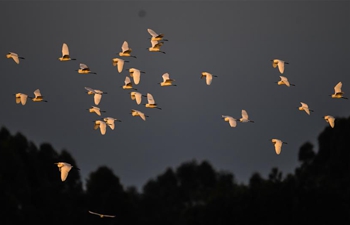SYDNEY, Dec. 13 (Xinhua) -- A study led by Australian scientists has mapped for the first time how the world's deadliest malaria parasite is able to enter and infect human blood cells, greatly advancing the quest for a vaccine.
An international team of scientists led by Professor Alan Cowman and Dr Wilson Wong at the Walter and Eliza Hall Institute released their study on Thursday, which used cutting edge cryo-electron microscopy to create a 3D image of the parasite's "key" to infection.
The Plasmodium falciparum parasite kills more than 500,000 people per year, most of which are women and children -- and the point at which it enters the bloodstream is when it begins to rapidly multiply and spread, causing the most debilitating symptoms.
The "key" to the parasite entering the bloodstream is a complex of three parasite proteins -- called Rh5, CyRPA and Ripr -- which work together to unlock and enter the cell, Cowman explained.
"This complex is fundamental to the malaria parasite's ability to enter cells and cause infection," he said.
The team used the world's most advanced cryo-electron microscope, the Titan Krios in the U.S, to map the complex in detail, giving scientists a clear picture of what they are up against.
"With this new information we can now target the parasite in a much better way because we understand how it functions to infect the blood," Cowan said.
The team obtained hundreds of thousands of images which they were then able to assemble these together, revealing the first-ever high resolution, 3D image of the insidious complex.
"We now have the information required to design a vaccine that gives the immune system precise instructions about how to stop the malaria parasite," Cowan said.
"If we can block the protein complex from forming, Plasmodium falciparum will never have the key it needs to infect human blood cells."













